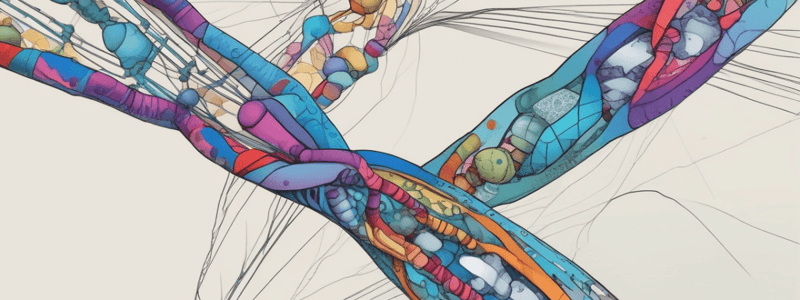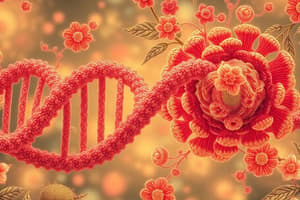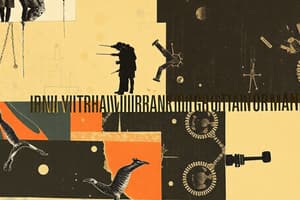Podcast
Questions and Answers
What is the primary function of introns in DNA?
What is the primary function of introns in DNA?
- To replicate DNA
- To separate exons (correct)
- To code for proteins
- To regulate gene expression
Which complex catalyzes the process of exon ligation?
Which complex catalyzes the process of exon ligation?
- Ligase
- Ribosome
- Helicase
- Spliceosome (correct)
What is the primary mechanism by which alternative splicing generates multiple mRNA isoforms?
What is the primary mechanism by which alternative splicing generates multiple mRNA isoforms?
- By changing the reading frame
- By including or excluding specific introns
- By modifying exon-intron boundaries
- By including or excluding specific exons (correct)
Which snRNP recognizes the 3' splice site?
Which snRNP recognizes the 3' splice site?
What is the dynamic complex that assembles on the pre-mRNA during splicing?
What is the dynamic complex that assembles on the pre-mRNA during splicing?
What is the primary function of the U1 snRNP in splice site recognition?
What is the primary function of the U1 snRNP in splice site recognition?
What was the initial observation that led to the discovery of introns?
What was the initial observation that led to the discovery of introns?
What is a characteristic feature of introns?
What is a characteristic feature of introns?
What is the term for the remaining RNA sequences after splicing?
What is the term for the remaining RNA sequences after splicing?
In which type of organism were introns first detected?
In which type of organism were introns first detected?
What is the process of eliminating internal RNA sequences and joining the remaining fragments?
What is the process of eliminating internal RNA sequences and joining the remaining fragments?
In which type of organisms or cells can introns be found?
In which type of organisms or cells can introns be found?
What is the term for the process of joining exons?
What is the term for the process of joining exons?
What is the result of splicing in terms of RNA structure?
What is the result of splicing in terms of RNA structure?
What was the observation that led researchers to suspect the presence of introns?
What was the observation that led researchers to suspect the presence of introns?
What is the approximate percentage of the sequence that introns can represent in some genes?
What is the approximate percentage of the sequence that introns can represent in some genes?
What is thought to be the advantage of having introns in genes?
What is thought to be the advantage of having introns in genes?
Which type of intrones are typically found in mitochondrial genes of fungi and yeast?
Which type of intrones are typically found in mitochondrial genes of fungi and yeast?
What is the outcome of the splicing process in terms of the original transcript length?
What is the outcome of the splicing process in terms of the original transcript length?
What is the relationship between intron presence and gene expression?
What is the relationship between intron presence and gene expression?
What is the purpose of the endonucleolytic and ligase reactions in splicing?
What is the purpose of the endonucleolytic and ligase reactions in splicing?
Which of the following is a potential disadvantage of having introns in genes?
Which of the following is a potential disadvantage of having introns in genes?
What is the general trend regarding intron presence in eukaryotic genes?
What is the general trend regarding intron presence in eukaryotic genes?
What is the benefit of having introns in terms of evolutionary diversification?
What is the benefit of having introns in terms of evolutionary diversification?
Flashcards are hidden until you start studying
Study Notes
Splicing
Intron Definition
- An intron is a non-coding region of DNA that is removed during splicing
- Introns are intervening sequences that separate exons (coding regions)
- Introns are typically longer than exons and are removed to form mature RNA
Exon Ligation
- Exon ligation is the process of joining exons together after intron removal
- This process is catalyzed by the spliceosome, a large ribonucleoprotein complex
- Ligation occurs in a specific order, with the 5' exon being ligated to the 3' exon
Alternative Splicing
- Alternative splicing is a mechanism that generates multiple mRNA isoforms from a single gene
- This is achieved by including or excluding specific exons during splicing
- Alternative splicing increases protein diversity and is a key mechanism for regulating gene expression
Splice Site Recognition
- Splice site recognition is the process of identifying the 5' and 3' splice sites
- The 5' splice site is recognized by the U1 snRNP, while the 3' splice site is recognized by the U2 snRNP
- The U1 and U2 snRNPs bind to the pre-mRNA and define the exon-intron boundaries
Spliceosome Assembly
- The spliceosome is a dynamic complex that assembles on the pre-mRNA
- Assembly involves the recruitment of snRNPs (U1, U2, U4, U5, and U6) and other protein factors
- The spliceosome undergoes conformational changes during splicing, allowing for the precise removal of introns and ligation of exons
Studying That Suits You
Use AI to generate personalized quizzes and flashcards to suit your learning preferences.




